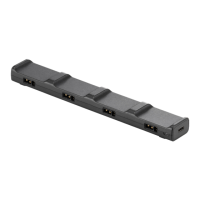DJI Avata
User Manual
43
© 2022 DJI All Rights Reserved.
3. Transmission
The Transmission menu has a Pilot sub-menu and Audience sub-menu.
• The video transmission settings for the current device can be set under the Pilot sub-menu, including but
not limited to:
a. Enable or disable the broadcast mode. The device number will be displayed when Broadcast mode is
enabled so that other devices can nd the device and enter the channel to see the camera view.
b. Set the focus mode to on, o, or auto. If Focus mode is turned on, the center of the screen will be
clearer and the edges will be blurred.
c. Set the channel mode to auto or manual. It is recommended to select auto so that the video
transmission will intelligently select the channel with the best signal.
d. Set the frequency band. Only 5.8 GHz frequency band is supported.
e. Set the bandwidth of the video transmission. The number of channels available varies according to the
bandwidth. The channel with the best signal strength can be manually selected.
The larger the bandwidth, the more spectrum resources it occupies, which provides a higher video
transmission rate and clearer image quality. However, there will also be a higher chance of wireless
interference and the amount of equipment that can be accommodated will be more limited. To avoid
interference in a multiplayer scenario, manually select a xed bandwidth and channel.
• If any nearby video transmission device turns on the Broadcast mode, the device and its signal strength can
be viewed in the Audience sub-menu. Select a channel to see the camera view.
4. Settings
• Safety
a. Set the safety congurations such as max ight altitude, max ight distance, and RTH altitude. Users
can also update the Home Point, and view the IMU and compass status and calibrate them if necessary.
b. Find My Drone helps to nd the location of the aircraft on the ground by using the cached video in the
goggles. If the aircraft still has battery, turn on ESC beeping to help nd the aircraft using sound.
c. Advanced Safety Settings include aircraft signal lost action, enabling/disabling AirSense, and emergency
propeller stop. The aircraft can be set to hover, land, or RTH when it loses the signal from the remote
control devices. If the emergency propeller stop is enabled, the motors can be stopped mid-flight
anytime once the user presses the lock button twice on the motion controller or performs a combination
stick command (CSC) on the remote controller. If the switch is disabled, the motors can only be
stopped by pressing the lock button twice on the motion controller or performing a CSC mid-ight in an
emergency situation, such as if a collision occurs, a motor stalls, the aircraft rolls in the air, or the aircraft
is out of control and is ascending or descending quickly.
Stopping the motors mid-ight will cause the aircraft to crash.
• Control
a. Set stick mode and customize functions of certain remote controller buttons in Remote Controller. The
exponential can be adjusted when using Manual mode. Users can also calibrate the remote controller.
b. Calibrate the motion controller, or view its tutorial video.
c. Calibrate the gimbal or adjust the gimbal tilt speed.
d. Set the unit, or invert horizontal swipe for the touch panel.
e. Use ip function.
f. Watch the goggles tutorial.
• Camera
a. Set video quality, camera FOV, EIS (electronic image stabilization), gridlines, enable or disable the
center point of the screen, and format the microSD card. Note that the data cannot be recovered after
formatting. Operate with caution.
b. In Advanced Camera Settings, users can set the recording device, color, and anti-icker, as well as
enable or disable auto record on takeo, and video subtitles.

